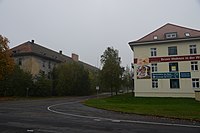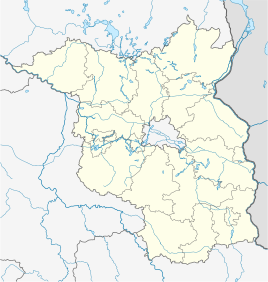Hohenfriedberg barracks (Bad Freienwalde)
|
|
|||
|---|---|---|---|

Hohenfriedberg barracks, entrance "Am Sparrenbusch" |
|||
| country | Germany | ||
| local community | Bad Freienwalde (Oder) | ||
| Coordinates : | 52 ° 46 ' N , 14 ° 1' E | ||
| Opened | 1935-1936 | ||
| Formerly stationed units | |||
| Motorcyclist Battalion 3 Rifle Replacement Battalion 8 5th Jägerdivision 16th Guards Mot. Rifle Regiment 6th Guards Panzer Regiment 6th Guards Tank Regiment |
|
||
|
Location of the Hohenfriedberg barracks in Brandenburg |
|||
The Hohenfriedberg-Kaserne am Sparrenbusch was a barracks in Bad Freienwalde , which was built from 1935 to 1936 and used by the Wehrmacht , the Red Army , the Soviet Army and the armed forces of Russia until 1993.
Surname
The barracks was named after the Battle of Hohenfriedberg . The rafter bush is an elevation on the slope of the Barnims to the Oderbruch . The forest, where the barracks were built from the mid-1930s, bears this name because it belonged to the family of Otto Christoph von Sparr .
location
The former Hohenfriedberg barracks is located on the B158 ( Berliner Straße ) on the western outskirts of Bad Freienwalde towards Berlin on the Barnimabhang.
history
As part of the armament of the Wehrmacht , the barracks were built from 1935 to 1936. Numerous Bad Freienwalder construction companies were able to win orders through the construction contracts. The staff building was built by the construction company Otto Seidemann from Freienwalde . On September 17, 1937, was handed over to the motorized infantry - battalion 3. motorized infantry battalion 3 came from Erfurt, where it was stationed as a squadron of the 9th Cavalry Regiment 16 since 17 September 1925. In the course of the reorganization of the Wehrmacht, the cavalry regiment was motorized and the 9th squadron relocated to Bad Freienwalde under the battalion commander Günther von Manteuffel, where the advance command arrived on September 24, 1935. In addition, police officers from the Schutzpolizei (Schupo) from the state companies of Breslau , Stettin and Köslin were integrated into the battalion. The 3 motorcyclist battalion was part of the 3 rifle regiment from Eberswalde and with this subordinated to the 3rd Panzer Division .
Since the construction work on the rafter bush was not yet finished, only residential barracks were initially available for part of the battalion. Part of the battalion was also housed in Wriezen . On June 10, 1936, the barracks were finally released and all parts of the battalion could move into the rafter bush.
At the same time, three eight-family houses for NCOs were built in Berliner Strasse, further apartments for military personnel in Graf-Haeseler-Strasse (today August-Bebel-Strasse), an officers' mess and a shooting range. At the corner of Berliner Strasse and August-Bebel-Strasse, the building for the Army Site Administration was built. Two-family houses were built for barracks employees on Dragonerstraße (today Am Park).
On February 7, 1940, the 8th Rifle Replacement Battalion was relocated from Frankfurt (Oder) to Bad Freienwalde. The battalion was then transferred to Eberswalde on October 28, 1940.
On April 1, 1945, the refreshed 5th Jägerdivision was relocated from the Ueckermünde area to Bad Freienwalde, between the 606th Infantry Division in Wriezen and the 1st Marine Infantry Division north of the Hohenzollern Canal at the battle of the Seelower Heights to participate. After the 606th Infantry Division could not hold Wriezen on April 19, 1945, the 5th Jägerdivision and the 606th Infantry Division withdrew to the third defensive strip on the Barnimabhang ("Wotanstellung"). On April 20, 1945 the retreat towards Eberswalde followed and the city of Bad Freienwalde was taken by the Soviet troops without a fight. The Hohenfriedberg barracks were immediately taken over by the Soviet Army.
From 1946 to 1993, Soviet and Russian combat troops were stationed in the Hohenfriedberg barracks. From 1946 to 1985 the 16th Guards - Mot.-Rifle Regiment Lviv (GdMSR) of the 6th Guards-Mot.-Rifle Division was stationed in the barracks. The unit for the liberation of Lviv (Russian: Lviv) was given the honorary name Lviv on July 27, 1944. After renaming and restructuring in 1985, this became the 6th Guards Panzer Regiment Lviv (GdPR) of the 90th Guards Panzer Division (90th GdPD Bernau ), which was relocated back to Russia in 1993.
After the site was closed, the area at Sparrenbusch was converted into civilian living space and today's forest town was created.
Stationings
1937-1945
Motorcyclist Battalion 3 of the 3rd Rifle Regiment
Subordination: 3rd Rifle Regiment (Eberswalde), 3rd Panzer Division
1940-1940
Rifle Replacement Battalion 8
1945
5th Hunter Division
1945–1985
16. Guard Motorized-protecting regiment "Lwiw" (GdMSR), Lenin , Red Banner , Suvorov , Order of Kutuzov , Order of Bogdan Khmelnitsky
Full Russian Name: 16-й гвардейский мотострелковый Львовский ордена Ленина Краснознамённый орденов Суворова, Кутузова и Богдана Хмельницкого полк (в / ч п / п 60524) Бад-Фрайенвальде
Subordination: 6th Guard Motorized Rifle Division (GdMSD Bernau)
1985-1993
6th Guard Panzer Regiment "Lviv" (GdPR), Order of Lenin, Order of the Red Banner, Order of Suvorov, Order of Kutuzov, Order of Bogdan-Khmelnitsky (Bad Freienwalde)
Full Russian name: 6-й гвардейский танковый Львовский ордена Ленина Краснознамённый орденов Суворорова, куану (Биворока, куану (Биворока), куану (Биворока, куану (Биворока), куану (Биворока, куану (Биворока), куану (Биворока), куану (Биворока)
Equipment 1990: 93 T-80 , 58 BMP (24 BMP-2 , 30 BMP-1 , 4 BRM-1K), 2 BTR- 60, 18 2Cl, 6 BMP-1KSH, 2 PRP-3/4, 3 RCM, 1 R-145BM, 3 PU-12, 2 MT-55A
Subordination: 90th Guards Panzer Division (90th GdPD Bernau)
Individual evidence
- ^ Theodor Fontane: The walks. Volume 2: The Oderland. Barnim / Lebus. 2nd volume. Friedrich Wilhelm Hendel Verlag, Naunhof and Leipzig 1940, p. 434-451 .
- ^ Albert Seidemann: History of the Thuringian-Saxon-Märkische Seidemann family from 1470 to the present . Mitteldeutscher Nationalverlag GmbH, Berlin 1940, p. 218-220 .
- ↑ a b c d Rudolf Schmidt: Soldiers again in the Oberbarnim . In: Rudolf Schmidt (ed.): Oberbarnimer district calendar . Verlagsgesellschaft R. Müller mbH., Eberswalde 1937, p. 13-17 .
- ^ A b Gundula Kaczmarek, Werner Kaczmarek: Bad Freienwalde free from the military . In: Cäcilie Breßler (ed.): Freienwalder district calendar . tape 37 . Bad Freienwalde 1993, p. 29-33 .
- ^ Adolf Reinicke: The 5th Jäger Division . Dörfler Verlag, Eggolsheim 2003, ISBN 978-3-89555-103-1 , p. 355-358 .
- ↑ a b c d 16-я гвардейская механизированная бригада. ru.wikipedia.org, accessed October 19, 2019 (Russian).

